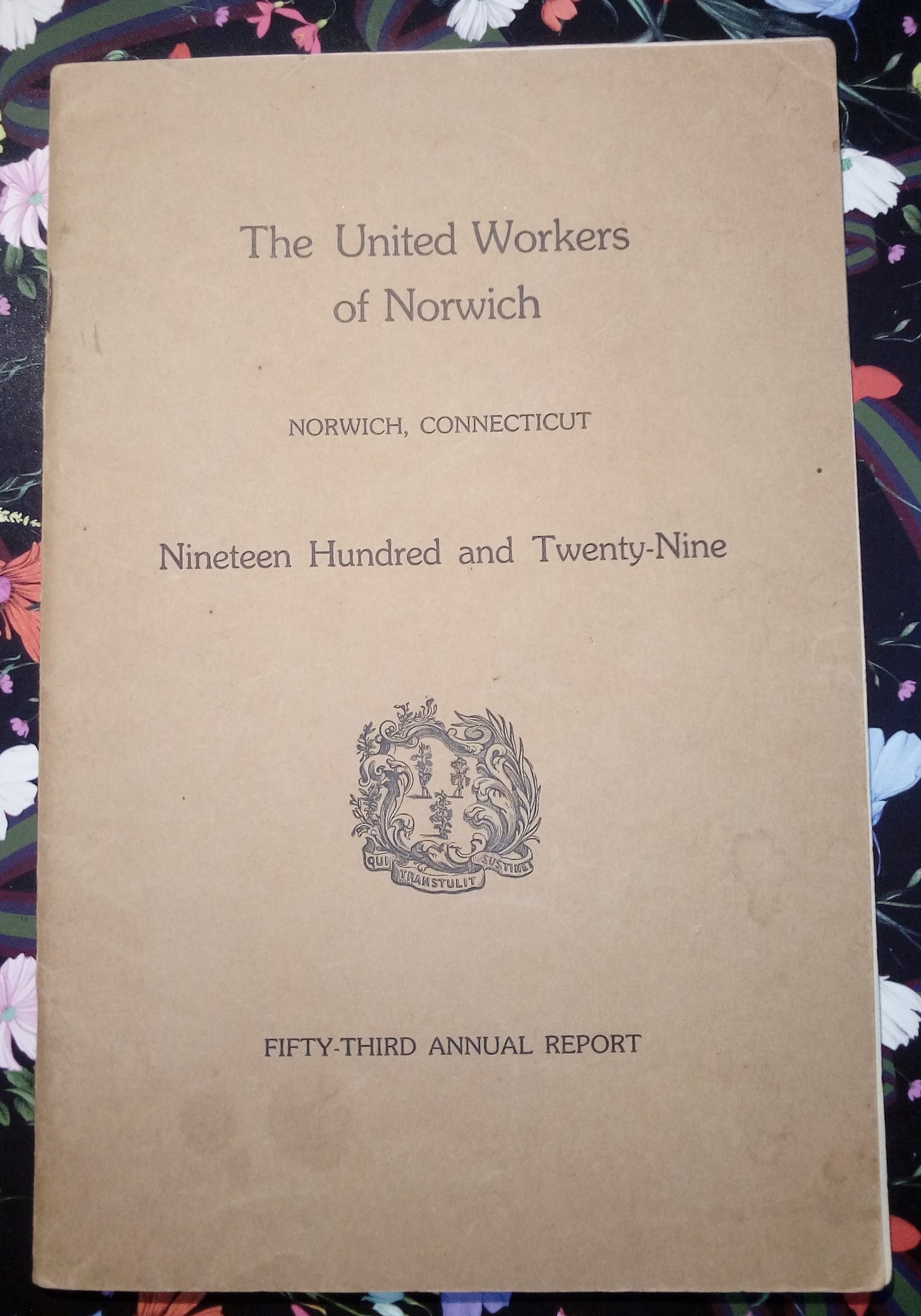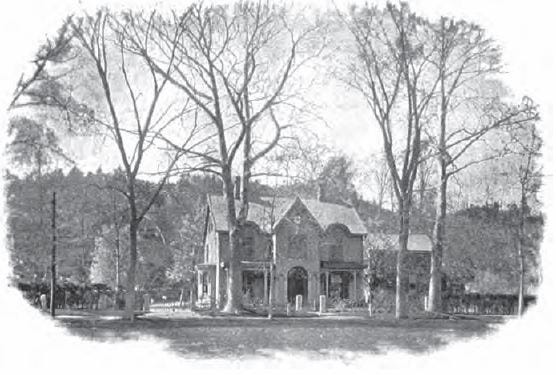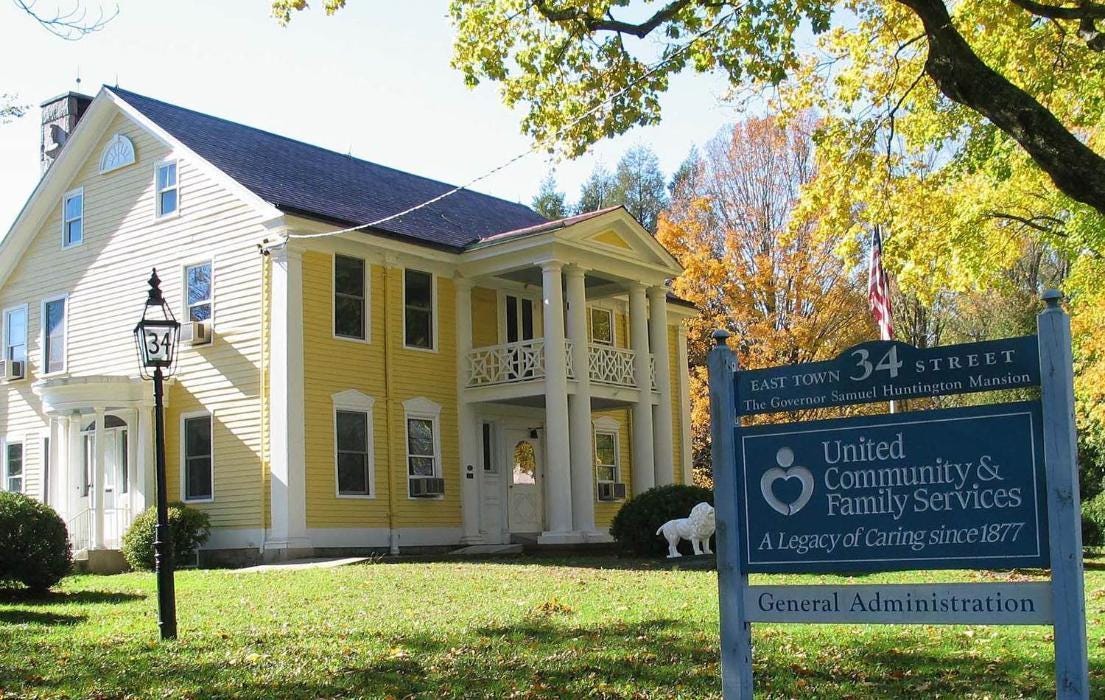I picked up this pamphlet at the Brimfield flea market a few years ago based on its title. “United Workers!” I thought. “It must be a labor organization, cool!”

Friends, I was wrong. The United Workers of Norwich, Connecticut was a social welfare organization incorporated in 1878 for the purpose of “the relief of suffering and the elevation of destitute women and children” in Norwich. It was the type of organization that, remarkably, gets less attention from historians than labor organizations.
Then – 1878
Let’s take a look at the names of the founders, as listed in its charter, and then guess why the United Workers of Norwich doesn’t get much historical attention:
Sarah A. Huntington
Lucy A. Jewett
Maria P. Gilman
Sarah L. Giesey
Myra Mitchell
Fannie P. Palmer
Emily Davies
Carrie L. Thomas
Mary H. Seymour
Mary R. Greene.
See the common element there?
But wait, there’s more! The “United Workers” were not a grassroots organization of working-class people. No, I found nine of these 10 middle-aged white women in the 1880 census for Norwich, and they were all well-off enough to have live-in servants and support a variety of relatives and others. Two of them (Gilman and Thomas) had never married, yet were able to support multiple non-working relatives – that suggests inherited wealth. Four of them (Huntington, Jewett, Mitchell, and Davies) were widows, supporting adult and/or younger relatives with their own or their husbands’ money. In Jewett’s case, her household also included three 19-year-old Chinese boys who were students. Three of them (Giesey, Palmer, and Green) were married, two to clergymen and one to an iron manufacturer. Palmer’s household included a boarder who was artist named Mary A. Phipps.
In short, the founders of UWN were wealthy and generally conformist philanthropists, looking to make use of the energies they were not supposed to put into things that were claimed to be the male domain (like business, or politics, or science, or higher education). In 1878, the married women had only just gotten the legal ability to hold property in their own name, rather than their husbands’.
The organization’s charter (granted by the state legislature in 1878, and amended in 1889, 1893, and 1917) allowed it to hold up to $200,000 in real estate and also gave it “the same powers in regard to the adoption of children as are given by Section 471 of the General Statutes to the board of management of orphan asylums chartered by the state.”
Then - 1929
As of 1929, the UWN had been operating for 53 years. As printed in the annual report, its constitution stated that its purpose was “the promotion of practical benevolence in the Town of Norwich.” This is interesting, because there was also a City of Norwich, yet this document seems to ignore its existence. Unsurprisingly, given the time period, the group laid claim to the term “nonsectarian” by asserting that membership was open to “all earnest Christian Workers in the community.” That phrase may explain why it called itself “United Workers” – it was made up of people seeking to do good works (though only Christians). Also, in the course of outlining the officers’ roles, the constitution assumed that the officers would all be women.
So, 53 years on, what was this organization doing?
No, wait, let’s look at its finances. The bottom line of its financial statement was $963,687.47. Yes, that’s nearly a million dollars, in 1929 dollars. According to US Inflation Calculator, that would be $15,050,097.41 in today’s dollars. This organization was loaded.
But then, looking deeper, we find that it had $98,605.88 tied up in real estate – the United Workers’ House, the Rock Nook Children’s Home, and Sheltering Arms. They had also issued mortgage loans valued at $20,700, had $40,574.02 in six different savings banks, owned $458,086.79 in stocks, and held $332,860.46 in bonds. They were mainly operating off “interest and dividends” ($47,068.22), receipts from investments ($67,707.43), and receipts from legacies in cash ($47,241.40).
This was, of course, the year during which the stock market crashed and took most of the economy with it. Remember, though, that this annual report was compiled in January 1930, when the scope of the rolling economic disaster had not yet become clear. No doubt its finances suffered in the succeeding years.
Turning back to the people and their activities, all of the officers and virtually all of the standing committee members were still women. The auditors (who needed to be accountants) were men, and there was an eight-member advisory board that was also all men (which included the organization’s attorney).
Let’s just look briefly at the seven top officers, using the 1930 census (first pause to breath and count to 10):
Mrs. Albert H. Chase = Ada R. Chase
Mrs. Charles B. Gilbert = Helen F. Gilbert
Miss Adelaide L. Butts
Miss Matilda Butts
Mrs. Harvey M. Briggs = Hortense M. Briggs
Mrs. Henry H. Pettis = Martha A. Pettis
Mrs. William H. Oat = Anna L. Oat.
This was a much more middle-class group, still middle-aged, and with much smaller households. Only two (Chase and Gilbert) had a live-in servant, but then such arrangements were much less common in 1929. Their spouses were in sales (hardware, auto supplies), a lawyer, and the editor and the publisher of the Norwich Bulletin newspaper. The Butts sisters, both in their 70s and never married, lived together with no one else. And there was one major departure from the 1878 group: Helen F. Gilbert gave her occupation as high school teacher.
I did notice, as I went through the report, that the women submitting the committee reports did put their own given names on them.
We could be here forever looking at the rest of the vice presidents and committee members. Instead, let’s talk about the committees, briefly. There was one for the United Workers’ House, which held offices and classrooms; the committee’s secretary included a line in her report that endears her to me, saying that “we all know that an old house requires eternal vigilance to keep it in good repair” (p. 9).
This house was at 9 Washington Street, and a little judicious searching found a scanned photograph of it posted on Facebook. At present, it appears that the building no longer exists.

The Family Welfare Department, headquartered here, rendered assistance to 305 families, ranging from medical and dental treatment to employment assistance to cash loans, as well as material goods; they also collected and distributed Thanksgiving dinners and Christmas toys and candy. The Public Health Nursing Department undertook prenatal and newborn education and care, work with handicapped children, tuberculosis care, smallpox vaccination, and miscellaneous medical care. They also were part of making “Alpine Light treatment” available to children at the Rock Nook Clinic. I think, based on some quick research, that this treatment involved therapeutic application of ultraviolet light. Altogether the visiting nurses and the clinics worked with over 3,000 patients during the year. There was also the Club Committee, which did “Club Work.” The committee report clarifies that they gave cooking and sewing classes to girls, apparently using the headquarters classrooms.
The Norwich Neuropsychiatric Clinic was a program in its sixth year, and was about to change its name to Norwich Mental Hygiene Clinic. This isn’t the place to go into the whole concept of mental hygiene – it’s complicated in all the ways that early mental health movements were – and anyway the committee’s report talked far more about education and going to meetings than actual activities. It was apparently located in Backus Hospital.
The Sheltering Arms was apparently a small convalescent home. This facility was started as one of the UWN’s first projects and was originally located in this building:
According to Old Houses of the Antient Town of Norwich, 1660-1800 by Mary E. Perkins (1895), this house (built by the fourth Thomas Leffingwell some time after 1733) was on the old Canterbury road, and was sold to the United Workers in 1878, who used it to aid “the sick and the suffering” (p. 48).
By 1929, however, the Sheltering Arms was located at 165 McKinley Avenue, according to the annual report. The City of Norwich’s online records say that the convalescent home there was built in 1925. Its staff cared for 23 patients during the year, held a number of special events, and received donations of a grandfather clock (from the family of a deceased committee member), dining-room china, and 148 items from the Needlework Guild.
The Rock Nook Children’s Home was an orphanage. Again according to Perkins’ Old Houses of the Antient Town of Norwich (p. 365), this was the building it was set up in:

The house seems to have been built before the Revolution by Jesse Brown, who ran a tavern in it. In this photograph, however, its appearance is much more mid-nineteenth century than that; Perkins herself noted that it was “much altered and modernized.” She also reported that it was donated to the United Workers by Moses Pierce, who had purchased in in 1855 (p. 367). According to the 1929 annual report, the facility held an average of 30 children a month, and also benefited from donations by the Needlework Guild.
The Riverside Home was apparently another convalescent home, which had 65 residents at the end of the year, but was not the property of UWN. It seems they had been given responsibility to “visit” or inspect it.
The volunteer staff, and the accountants, had the responsibility of managing the funds (including many memorial funds and restricted bequests) of an organization with multiple facilities staffed by paid employees and volunteers. In 1929, the women in charge, or at least the ones I looked at, had all been born before 1900. Had they had any formal education that helped them with the job? Or was it all “hands on” experience, because they were still pushing up against the limits that society had placed on their interests and ambitions? I don’t know. This is a newsletter item, not a thesis.
Now - 2021
The other thing about The United Workers of Norwich is that, over 140 years after its founding, it still exists, albeit under the name United Community & Family Services. It seems to have pivoted to the health care field (no more orphans or sewing classes), and is very active in the community and on social media. According to its 2020 annual report, issued while the COVID-19 pandemic was still grinding on, its operational revenue was $33,957,805 and its operational expenses were $35,703,813. No longer an all-female-led organization, it ran multiple health-related programs at schools in Norwich and was active in seven other eastern Connecticut towns as well.
Those 10 women in 1878, who did not yet have the right to vote, started an organization that lasted over 140 years – longer than most of the profit-making corporations founded by men at the time, which their socioeconomic status kept them from being part of.
Also, here is the location of the Sheltering Arms home (now including the Ross Adult Day Center), built in 1925:

And here is the location of Rock Nook Community Behavioral Health Programs:

Almost as fascinatingly, at some point during the twentieth century they moved their headquarters into the Governor Samuel Huntington House at 34 East Town Street:

So, if anyone out there is looking for a thesis project on American women’s charitable organizations in the late nineteenth and early twentieth centuries, here you go. I found the 14th annual report (1891) scanned into Google Books, and further searching there found other “United Workers” reports from other cities. And I’ll give you a scan of the 1929 annual report, too.



